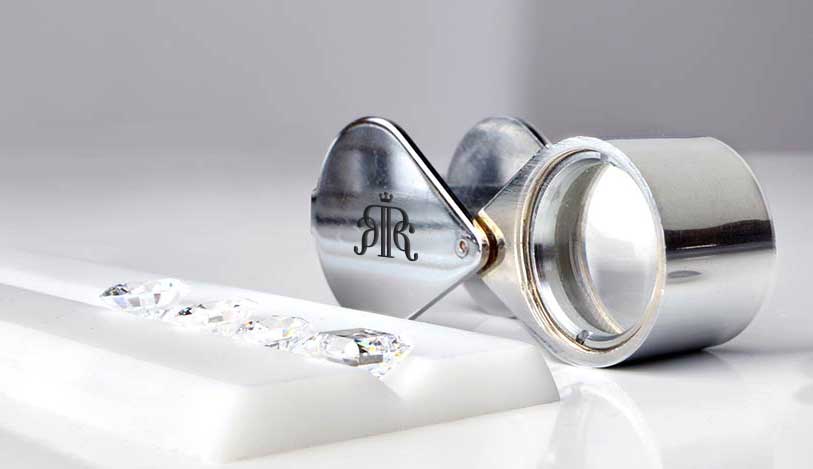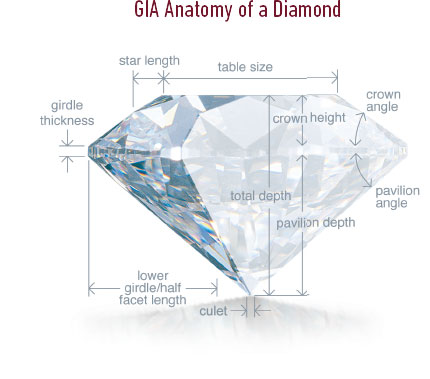The Four C’s

Every diamond has its own special message and each diamond sparkles in its own particular way. When you hold a diamond, or wear it, you’ll notice how it feels. Move it around and watch the way it shimmers. You will see that some diamonds flash like fireworks while others are serene like a calm lake.
A diamond is personal. It touches your soul and it has a connection to you. It’s your connection to a diamond that makes you fall in love with it. Connection is the Fifth C.
In addition to its connection to you, there are some universal standards by which diamonds are evaluated that determine its value — the Four C’s: color, clarity, carat and cut. Each of the criteria affects the quality and value of a diamond. The Gemological Institute of America (GIA) set the standard for grading diamonds when it introduced its International Diamond Grading System in 1953. It has since become the global standard for evaluating diamonds.
In a white diamond, the grading scale is D through Z. Ideally, there should be no color in a white diamond, it should be as transparent as a window; clear like glass. But the body of a diamond often has slight tones of gray, yellow or brown. As these tones become more visible in the diamond, the color grade goes down. D color diamonds will have no body color, while a diamond in the Z range will have a distinct tinge of color. Many of the in-between letter grades, especially H and above, will appear colorless or near-colorless in the face-up position.

Diamonds, like anything else borne out of nature, will have birthmarks, known as inclusions when they are inside the stone and blemishes when they are on the outside of the gem. These marks impact the clarity of the stone. The less inclusions or blemishes in the stone the better. The best is when there are none whatsoever, but that is very rare. When viewed under 10x magnification inclusions are rated by the GIA as follows: Flawless (F): No internal inclusions or external blemishes on the diamond. Internally Flawless (IF): No inclusions inside the diamond. Very, Very Slightly Included (VVS): Slight inclusions that are difficult to see under 10x magnification. This category is subdivided into VVS1 and VVS2 with VVS2 being a tiny bit more included than VVS1. These marks are not visible to the naked eye and can only be seen through 10x magnification.

Very Slightly Included (VS): Minor inclusions that are hard to see under magnification. There will be more marks than in a VVS stone. This category is also subdivided in to VS1 and VS2. The marks are not visible to the naked eye and can only be seen through 10x magnification. Slightly Included (SI): There are noticeable inclusions under 10x magnification. This category is also subdivided into SI1 and SI2, with SI2 being a bit more included. Sometimes these inclusions are visible to the naked eye. Included (I): The inclusions are obvious under 10x magnification. At the I1,I2 and I3 levels the inclusions may begin to affect the transparency and brilliance of a diamond making it appear a bit cloudy or like salt and pepper has been sprinkled through the diamond. Generally, these inclusions are visible to the naked eye.

Carat describes how much a diamond weighs. A metric carat is defined as 200 milligrams. In order to have more precise measurements, a carat is divided into 100 points, so a half-carat diamond would be .50 points. The word ‘carat’ originated from the Middle Eastern word for carob. Centuries ago, carob seeds were used to weigh gemstones.

 Cut is the arrangement of facets on the diamond. Of all the 4C’s, cut is perhaps the most important because the facets interact with light and are what create the sparkle and brightness in a diamond. Cut should not be confused with shape, which is the geometric form of the stone — round, square, rectangular, heart, pear or marquise.
Cut is the arrangement of facets on the diamond. Of all the 4C’s, cut is perhaps the most important because the facets interact with light and are what create the sparkle and brightness in a diamond. Cut should not be confused with shape, which is the geometric form of the stone — round, square, rectangular, heart, pear or marquise.


